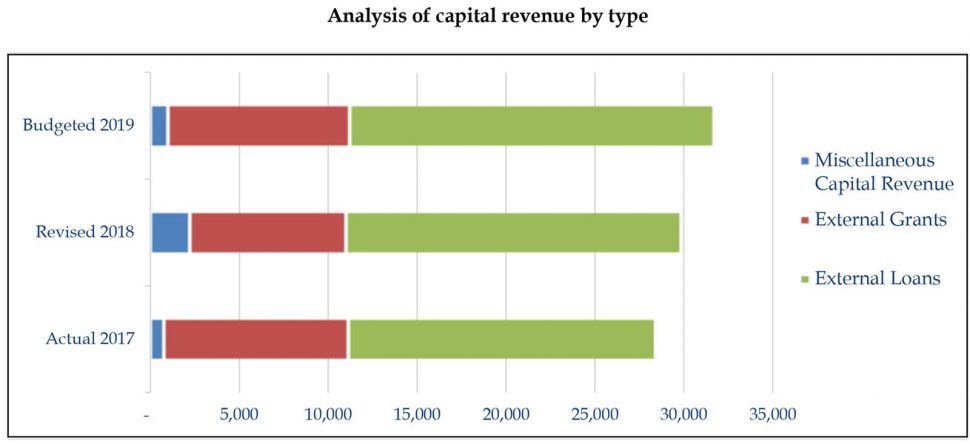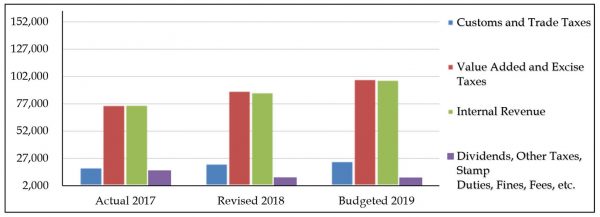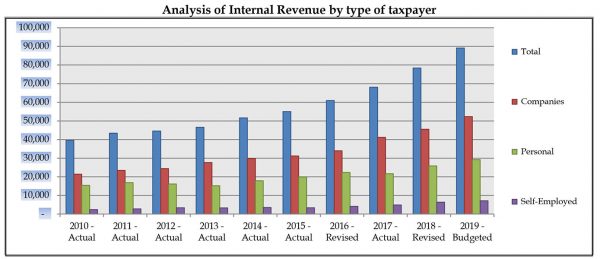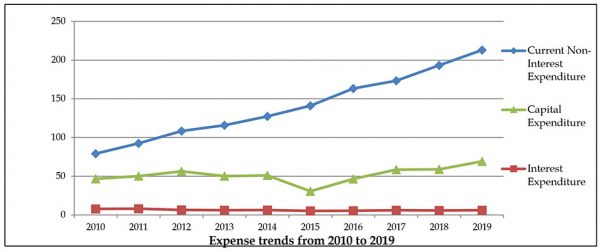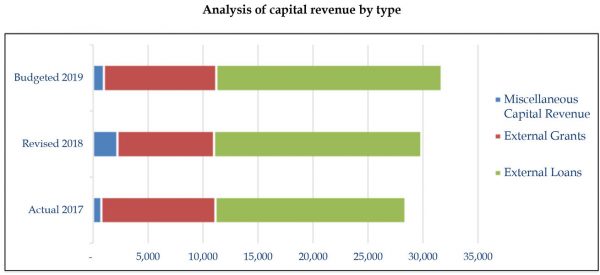The current balance projects a surplus of $19,017 million, an increase of $1,408 million or 8% over revised 2018. Current revenue of $238,322 million represents an increase of $21,452 million over the latest estimate for 2018 of $216,871 million (9.9%).
Budgeted current expenditure is $213,101 million, an increase of $19,690 million (10.2%) while Interest Expenditure is budgeted at $6,204 million, an increase of $353 million (6%) giving a Current Balance of $19,017 million compared with latest estimates for 2018 of $17,609 million.
Capital Revenue and Grants are budgeted at $10,240 million compared with $11,933 million for 2018. Budgeted Capital Expenditure is $69,279 million which is some $10,263 million over 2018. After Debt Repayment of $12,135 million, an overall deficit of $52,156 million is projected, compared with a deficit of $41,296 million in 2018, 39% of which is expected to be financed by borrowings from external sources and 61% from domestic sources. Of the current expenditure, personal emoluments account for approximately 33%. Debt service as a percentage of current revenue is projected at 7.7% in 2019, down from 8.1% in 2018.
The main elements of the 2019 Plan are:
Total current revenues are projected to increase by $21,452 million to $238,323 million or by 9.9%. Of this, the Guyana Revenue Authority is expected to account for revenues of $223,583 million or 93.8% of total revenue, an increase of $24,092 million or 12.1% when compared to 2018. Not only does increasing tax revenues appear to be a major policy objective of the Government but instead of using the increases to reduce the Budget deficit, the Government chooses to incur sometimes extravagant and avoidable expenditure. As a result, 2019 will see a widening of the deficit from $41,300 million to $52,156 million.
With more than $7,000 million of 2018 revenues deriving from the concluded Tax Amnesty, it means that the Government is budgeting to increase tax revenues in 2019 by some $31,000 million, all by way of taxes. The only item for which a reduction is budgeted is Other.
Current revenue by type
Source: National Estimates (G$ Millions)
Of the GRA’s collections, Internal Revenue is projected to account for $99,024 million compared with $87,850 million in 2018, a 13% increase, while Value-Added and Excise Taxes are expected to earn $99,669 million compared to $89,126 million in 2018, an increase of 11.8%. Collections by the Customs and Trade Administration are anticipated to be $24,890 million, an increase of $2,374 million or 10.5%.
Source: Estimates of the Public Sector, Volume 1. All amounts shown are actual except 2016 and 2018 being revised and 2019 being budgeted (G$ Millions)
Total current non-interest expenditure is projected to increase by $19,690 million from $193,412 million in 2018 to $213,102 million for 2019. Personal emoluments of $70,151 million represent an increase of 19% or $11,213 million over the revised figures for 2018. As a percentage of current non-interest expenditure, personnel emoluments account for 33%, Other Goods and Services 28% and Transfer Payments 39%.
Transfer payments are payments from the Government to individuals, organisations or other levels of Government made with the specific objective of furthering Government policy or programme delivery and for which the Government does not receive directly any goods or services.
Source: Estimates of the Public Sector, Volume 1. All amounts shown as actual except 2018 and 2019 being revised and budgeted respectively (G$ Millions)
Capital revenue and grants in 2019 are projected to decrease by 14.2% or $1,692 million to $10,240 million of which Project and Programme funds are projected to increase by $532 million or 5.5%, whereas HIPC and MDRI will not contribute in 2019.
Source: National Estimates (G$ Millions)
Capital expenditure of $69,279 million represents a projected increase of $10,263 million or 17.4% over revised 2018 of $59,016 million. The top five ministries in terms of capital expenditure are:
1. Ministry of Public Infrastructure;
2. Ministry of Finance;
3. Ministry of Agriculture;
4. Ministry of the Presidency;
5. Ministry of Public Telecommunications;
Significant Capital Expenditure of more than $1,000 million are as follows:
Ministry of Public Infrastructure
● $3,600 million provision for institutional strengthening and upgrading of electrification system – financed by IDB/EU/IsDB,
● $2,229 million provision for studies and construction of by-pass road – financed by INDIA for East Bank,
● $2,200 million for upgrading of highway – financed by CHINA for Highway Improvement East Coast Demerara,
● $2,000 million for the rehabilitation of Hinterland roads and payment of retention,
● $1,955 million for completion, construction and rehabilitation of roads and drains in various communities and payment of retention,
● $1,950 million for reconstruction and rehabilitation of sea defences,
● $1,800 million for provision for rehabilitation of Sheriff-Mandela Road – financed by IDB,
● $1,400 million for the completion, construction and rehabilitation of sea and river defences and payment of retention,
● $1,130 million for provision for modernisation of Airport and payment of retention under the CJIA Modernisation Project and,
Ministry of Finance
● $1,400 million for the provision for Low Carbon Development Initiatives – financed by Norway,
● $1,257 million for the provision of buildings, software, vehicles, furniture and equipment for the Guyana Revenue Authority;
Ministry of Agriculture
● $2,086 million for completion, construction and rehabilitation of drainage and irrigation structures, pump stations and payment retention;
We draw attention to spending on the Ministry of Presidency
● $713.6 million for the provision of furniture and equipment under Citizenship and Immigration Services,
● $659 million for the provision of sport facilities for National Sports Commission,
● $350 million for provision for Jubilee Republic initiatives under Social Cohesion,
● $200 million for the provision for institutional support for oil and gas sector IDA/IDB under the Oil and Gas Sector Development Programme,
● $163 million for the provision for upgrade of geodetic infrastructure survey and electrical works under Lands and Surveys,
● $150 million for the provision for management of selected protected areas – financed by Germany,
● $95 million for the provision for developmental, humanitarian and other activities,
● $57.8 million represents provision for buildings, security hut, lights, ceiling and windows for the Office and Residence of the President;
Ministry of Public Telecommunications
● $2,040 million is for the provision for National Broadband Project – financed by CHINA under the National Broad band Project.
Major funding sources are China, India, the IDB, Japan and IDA. While the Ministry of Finance has shown a penchant for the Islamic Development Bank, this lending is still minor compared with the traditional sources.
Please see section Who Gets What in 2019 for the allocation of current and capital expenditures by ministries and departments.
Interest expenditure is projected to increase by 6% or $353 million to $6,204 million. Domestic interest is projected to decrease by $275.2 million or 21%, while interest on external debt is projected to increase by $628 million or 14%. The average rate of interest paid in 2018 on domestic debt is 1.57% while on external debt the average rate is 1.72%.
The principal element of debt repayments is projected at $12,135 million (2018: $11,821 million), made up of domestic debt repayments of a projected $280 million (2018: $280 million), while external debt repayments are projected to increase to $11,855 million (2018: $11,541 million).
The projected overall deficit of $52,156 million is expected to be financed by external borrowings of $20,493 million and from domestic sources of $31,663 million.
Ram & McRae’s Comments
1. The trend of major deficit financing continues with deficits over the period 2015 actual to 2019 budgeted as follows: 2015 – $24 billion, 2016 – $38 billion, 2017 – $42.4 billion, 2018 – $54.5 billion and 2019 $52.2 billion – a total of $211 billion. A major contributor is in respect of personnel emoluments and the absence of any efficiency oversight by this Administration. This omission, or strategy is inadvisable and unsustainable.
2. Personal emoluments have increased from $44,661 million in 2015 exponentially to a projected $70,151 million in 2019, an increase of 57% or $25,489 million. This is a staggering increase particularly having regard to low inflation undermined by this perpetuation of borrowing. In 2010, personal emoluments totalled $28,367 million or 26.3% of current revenue.
3. The danger of deficit financing is that all things being equal, oil revenues for the early years after First oil will simply go to bridging the deficit and little left for investments and savings.
4. Included in pension costs is an amount of $3,875 million for Pension increases or 20.5% of the total pensions and social assistance budget. Given the modest salary increases announced by the Minister, this provision requires considerably more explanation.
5. With taxes increasing at a much faster rate than the growth of production sector, the oxygen is being depleted from the economy. This is not a good strategy for preventing the Dutch Disease.
